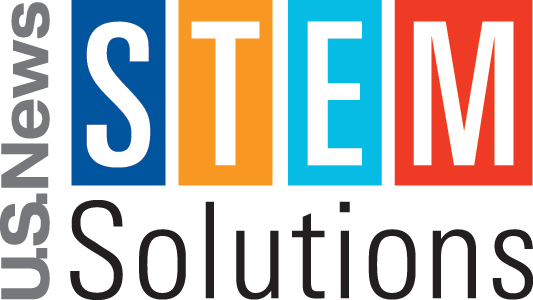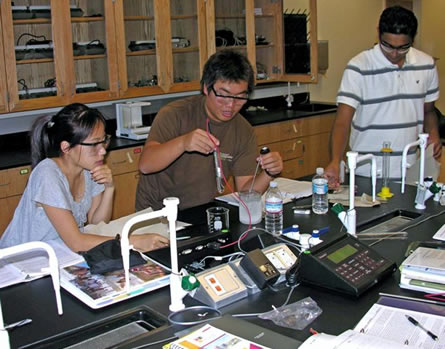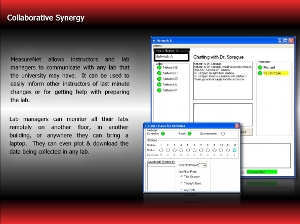
American students are falling into a giant chasm between the classroom and the workplace.
For three days in 2012, some of the biggest and brightest stars of business and education gathered in Dallas to explore the gap between the types of technical jobs that modern industry has to offer and the ability of workers to perform those tasks. As it stands now, workers simply do not have the advanced skills that employers need. High paying job positions go unfilled, leaving empty holes where a worker should be.
The STEM Solutions 2012 Summit tried to fill in the holes and build pathways that allow students to move more freely from the classroom to the STEM-rich workplace. During the summit, NMSI President & CEO Dr. Mary Ann Rankin encouraged listeners to accelerate STEM education in a panel discussion entitled, “The Supply Side: Education and America’s STEM Future.” The panel looked at various ways to produce enough STEM graduates to satisfy corporate hunger.
Summit participants agreed it is especially important to fill those positions with women.
STEMConnector’s new publication, 100 Women Leaders in STEM, featured Dr. Rankin. Women make up 48 percent of the workforce, yet hold only 24 percent of U.S. STEM jobs. Fewer than 15 percent of American engineers are female.
In another panel discussion, Dr. Rankin focused on defining, understanding and closing the gap between the skills needed by corporations and those offered by today’s universities.
This gap begins as small crevices in early education. Student brains stagnate through boring lectures and memorize facts instead of participating in hands-on education, known to excite young minds about science, technology, engineering and math, or STEM. This stagnation shows in dismal STEM scores. Barely 18 percent of high school seniors perform at proficient levels in science courses.
Weak STEM skills results in poor job prospects and low pay. A student without a solid understanding of STEM subjects cannot develop the technical skills necessary to participate in today’s job market. Employees with poor technical skills will ultimately fail in the modern, highly technical workplace.
Summit participants identified gaps between institutions, with each school adhering to slightly different standards and teaching methods. For example, a kid from one elementary school uses microscopes in the classroom while a child who attends school across town does not. These students eventually merge into a high school science class; the gap between the student with hands-on experience and the one without becomes clear quickly. This gap grows each time the students move from one institution to another, from elementary school to graduate school.
The summit called on educational institutions to fill in the gaps between elementary school, high school, college and graduate school. Many students fall into these gaps and away from careers in STEM fields. Improve each educational segment’s shared understanding of what is necessary to be “college-ready.”
MeasureNet is a prime example of educational technology that actually closes the gap between students and high paying jobs. MeasureNet puts real-world tools into the hands of students of all ages. Instead of sleeping through boring lectures, students use the same inquiry-based chemistry labs, environmental chemistry, instrumental methods, STEM and biochemistry procedures as professional scientists. MeasureNet helps students leap across the STEM chasm and land onto a great-paying job.

“Why do I have to learn junk I’ll never use in real life?” is arguably the most harrowing question to ever echo in a science or math classroom. For generations, an education in science, engineering or math has been mostly reserved for only those very bright students intending to pursue an advanced degree in one of those disciplines. Most of these students were white males, with strong social stigmas preventing females or students in minority groups from participating. Students who wanted to work in other professions or stay at home to raise kids often avoided science and math classes, thinking a working knowledge of these subjects unnecessary for a workaday life. Today’s fierce global economic climate does not allow modern student to cherry-pick skills to take into the workplace – even the most rudimentary jobs require a certain amount of technical sophistication and understanding of STEM subjects. While most students will not eventually work in a STEM field, they will enjoy life-long benefits from their experiences studying in a STEM-rich environment.
National Economy
A workforce well-educated in science, technology, engineering and math, or STEM, skills is now an absolute necessity to keep the United States in a competitive position in today’s global economy. According to a 2009 assessment of 15-year olds, the United States pulled a below-average ranking of 32nd in mathematics and an average rank of 23rd in science. These dismal statistics worry economists, industry leaders and politicians who recognize the power innovations science and technology has on the nation’s positions in the global markets. Knowledge is the engine that drives that innovation. Our nation needs an innovative strategy to its technical strength enough to compete in today’s global economy.
Improved Learning
One of the most obvious and innovative national strategies is to put STEM technology directly into the hands of high school students. STEM education transforms a teacher-centric classroom into a laboratory where curiosity and innovation propel discovery and learning. Cutting-edge STEM education tools replace dusty static textbooks with real-life technology. Lectures and memorization are swapped with curiosity and discovery, a more natural and long-lasting form of learning. The faces of students in an interactive STEM laboratory setting brighten as natural curiosity and inquisitiveness reawaken and reinvigorate their imaginations. The student shakes off her role as a passive learner and jumps right into the business of innovative thinking and learning. This type of exploratory thinking encourages valuable problem-solving and discovery skills students can use later in life, whether they plan to further their STEM education, go directly into the workforce or even stay at home and raise children.
Critical Thinking
Classes in STEM studies enhance critical thinking skills and require students to actively engage in a situation in order to find the solution. Students develop the same problem-solving skills in the secondary and post-secondary classroom as they will eventually use in the workplace. A savvy educator puts current technology into these students’ hands so they grow comfortable using these tools. Youngsters build STEM-specific proficiency along with critical thinking skills and familiarity with equipment as they go through secondary and post-secondary school or directly into the job market.
Increase Interest in STEM
Education in STEM studies during high school promotes interest in pursuing a post-secondary STEM degree. In a recent survey, four out of five STEM college students say they decided to study STEM while still in high school; more than half say that a specific class or a teacher, rather than a family member, got them interested in STEM subjects. This is especially true for women, with 68 percent of female students citing a teacher or a class as being the main motivation behind their decision to study STEM. Unfortunately, only one in five college STEM students say that elementary and high school adequately prepared them for college STEM courses. These students said it would have been helpful to take more STEM courses and for these courses to be more challenging.
Improved Collegiate Performance
The universities teaching advanced STEM courses would agree. One of the largest problems post-secondary institutions face is under-prepared freshmen. Universities and colleges yearn for entrants who are better educated in STEM subjects. Students entering STEM studies are woefully underprepared for collegiate courses and many students drop out before earning a degree.
Better Pay
Post-secondary STEM education results in better pay, even for workers who wind up in non-STEM positions. A person with a STEM degree will earn 13 percent more for the same job as another person without such credentials. This is especially true for women and minorities in STEM fields. While there is a gender and race gap associated with most other professions, women in STEM jobs make almost as much as their male counterparts.
The STEM skills learned in high school will serve a student well, even if she does not pursue a college degree or work in a STEM field. Even jobs in a big box store or fast food chain requires the use of hand-held electronic devices or scanners. Only repetitive, manual labor tasks do not require at least a fundamental education and the need for workers to perform this type of work has declined rapidly since the 1960s. Technology and robotics have replaced these workers with industrial machines. Today’s employers require interactive workers able to perform non-routine tasks based on a sound decision-making.
A secondary education rich in STEM studies benefits all students, whether they intend to pursue an advanced degree in the sciences or just work at the local discount store. STEM studies help students develop critical thinking skills, familiarize future workers with the equipment they will someday use and spark an interest in STEM fields. Improving secondary STEM education will improve our national workforce and enhance the way American workers do business.Discover all the learning solutions you can incorporate into your STEM laboratory.

Have you ever wanted to look in from your office or remote location to check on the progress of your lab students or an experiment you are running? Or what about sharing experiment data from this morning’s lab with rural student miles away with no lab access? With MeasureNet’s new Remote Monitor software, you can— whether you’re down the hall or across the country.
Designed with STEM partnerships and outreach activities in mind, Remote Monitor gives institutions without MeasureNet a chance to participate through the graphical viewing of acquired data files and the analysis of collected data via most any statistical or spreadsheet software. It also allows lab directors, instructors, and teaching assistants to monitor their MeasureNet networks from different physical locations.
Any station on any network can be monitored live or its saved files can be downloaded to any PC running Remote Monitor. Network chat boxes make it easy for teaching assistants to communicate with each other or with the lab manager. Remote Monitor also enables MeasureNet’s Cincinnati offices to quickly troubleshoot a network anywhere in the world as long as it is connected to the Internet. With appropriate IDs and passwords, a collaborating institution can have access to partner real-time lab experiments or saved data for research or outreach activities. Remote Monitor installs on any Windows-based PC connected to the Internet and doesn't require additional software or MeasureNet hardware.
MeasureNet Technology Ltd. manufactures patented, network-based data acquisition interfaces for science teaching laboratories. It is a spin-off of the University of Cincinnati's Department of Chemistry and is headquartered in Cincinnati, Ohio. Measurenet's award-winning, PC-reducing design helps reduce laboratory maintenance and operational costs while giving students access to high quality shared UV-vis spectroscopy, gas chromatograph connectivity, and an array of innovative probeware. Its acclaimed intuitive design provides improved transparency to enable better science-focused, not technology-focused, learning. Winner of the Ohio Governor's Award For Excellence in Energy Efficiency, MeasureNet networks are found in universities, community colleges, high schools, and vocational training centers across the United States and around the world.